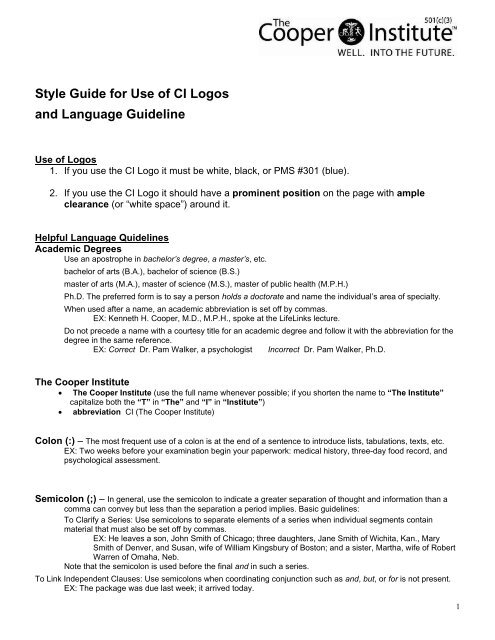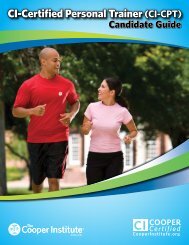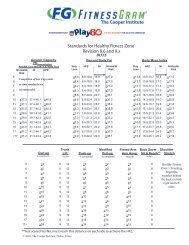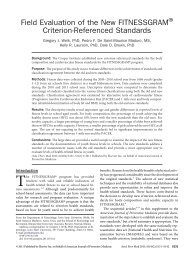STYLE MANUAL - Cooper Institute
STYLE MANUAL - Cooper Institute
STYLE MANUAL - Cooper Institute
You also want an ePaper? Increase the reach of your titles
YUMPU automatically turns print PDFs into web optimized ePapers that Google loves.
Style Guide for Use of CI Logosand Language GuidelineUse of Logos1. If you use the CI Logo it must be white, black, or PMS #301 (blue).2. If you use the CI Logo it should have a prominent position on the page with ampleclearance (or “white space”) around it.Helpful Language QuidelinesAcademic DegreesUse an apostrophe in bachelor’s degree, a master’s, etc.bachelor of arts (B.A.), bachelor of science (B.S.)master of arts (M.A.), master of science (M.S.), master of public health (M.P.H.)Ph.D. The preferred form is to say a person holds a doctorate and name the individual’s area of specialty.When used after a name, an academic abbreviation is set off by commas.EX: Kenneth H. <strong>Cooper</strong>, M.D., M.P.H., spoke at the LifeLinks lecture.Do not precede a name with a courtesy title for an academic degree and follow it with the abbreviation for thedegree in the same reference.EX: Correct Dr. Pam Walker, a psychologist Incorrect Dr. Pam Walker, Ph.D.The <strong>Cooper</strong> <strong>Institute</strong> The <strong>Cooper</strong> <strong>Institute</strong> (use the full name whenever possible; if you shorten the name to “The <strong>Institute</strong>”capitalize both the “T” in “The” and “I” in “<strong>Institute</strong>”) abbreviation CI (The <strong>Cooper</strong> <strong>Institute</strong>)Colon (:) – The most frequent use of a colon is at the end of a sentence to introduce lists, tabulations, texts, etc.EX: Two weeks before your examination begin your paperwork: medical history, three-day food record, andpsychological assessment.Semicolon (;) – In general, use the semicolon to indicate a greater separation of thought and information than acomma can convey but less than the separation a period implies. Basic guidelines:To Clarify a Series: Use semicolons to separate elements of a series when individual segments containmaterial that must also be set off by commas.EX: He leaves a son, John Smith of Chicago; three daughters, Jane Smith of Wichita, Kan., MarySmith of Denver, and Susan, wife of William Kingsbury of Boston; and a sister, Martha, wife of RobertWarren of Omaha, Neb.Note that the semicolon is used before the final and in such a series.To Link Independent Clauses: Use semicolons when coordinating conjunction such as and, but, or for is not present.EX: The package was due last week; it arrived today.1
Commas:When listing items in a sequence, include the comma preceding the article.EX: Correct: Running, walking, and cycling are all aerobic activities.Incorrect: Running, walking and cycling are all aerobic activities.Web Termse-maile-LearningInternetonline – One word in all cases for the computer connection term.web site – Two words in all cases.MonthsAbbreviate only Jan., Feb., Aug., Sept., Oct., Nov., and Dec. when used with a specific date. Spell out when using alone,or with a year alone.EX: January 1972 was a cold month.EX: She was born on Jan. 2, 1980.Month names with five or fewer letters are always spelled out: March, April, May, June, and July.NumbersSpell out numbers from one through nine, use numerals for 10 and above.Some exceptions:ages – Always use figures.EX: The 6-year-old girldates – Always use figures without st, nd, rd, or th.EX: Correct Oct. 8 Incorrect October 8thdecades – Use an apostrophe to indicate numerals that are left out; show plural by adding the letter s.EX: <strong>Cooper</strong> Aerobics Center was founded in the ’70s.EX: the 1890s, the mid-1930sNote: you can make the reverse apostrophe on your computer by holding down control and clickingthe apostrophe, quote keyfractions – Spell out amounts less than one when used in a sentence, using hyphen between the words: twothirds,four-fifths, seven-sixteenths, etc. Use figures for precise amounts larger than one, converting todecimals whenever practical.In tabular material, use figures exclusively, converting to decimals if the amounts involve extensive use offractions that cannot be expressed as a single character.money – Always use figures, do not include zeros after the decimal point.EX: Correct $40 Incorrect $40.00recipes – Always use figures. See FOOD.times – Use figures except for noon and midnight.a.m., p.m. Lowercase with periods, eliminate extra zeros. Avoid the redundant 10 a.m. this morning.EX: Correct 6 a.m. Incorrect 6:00 a.m.2
Commonly Used Words and Definitionsa lot – never alotaccept, except – Accept means to receive, except means to exclude.affect, effect – Affect, as a verb, means to influence. Affect, as a noun, should be avoided. Effect, as a verb, means tocause. Effect, as a noun, means result.EX: The game will affect the standings.EX: The effect was overwhelming.EX: He will effect many changes in the company.all right – Never alright.build up, buildup, build-up – Buildup is a noun. Build up is a verb. Never use build-up.EX: The EBT scanner easily recognizes and measures calcium buildup in the coronary arteries in anoninvasive way.childcare, child care – We use childcare, one word.compliment, complement – Compliment is a noun or a verb that denotes praise or the expression of courtesy.Complement is a noun and verb denoting completeness or the process of supplementing something.dietitian – Not dietician.definite – Not definate.ensure, insure – Use ensure to mean guarantee. Use insure for references to insurance.EX: Many studies were conducted on <strong>Cooper</strong> Complete to ensure its purity.EX: The policy insures his automobile.farther, further – Farther refers to physical distance. Further refers to an extension of time or degree.EX: Each year <strong>Cooper</strong> Fitness Center members are encouraged to run farther.EX: <strong>Cooper</strong> Wellness Program further enhances participants’ lives.healthcare, health care – We use health care, two words.i.e. – An abbreviation for the Latin id est, meaning “that is.” Use the English equivalent in sentences.EX: Her vacation was cut short by a family emergency – that is (not i.e.), the birth of her dog’spuppies.it, its, they, their – See PRONOUN-ANTECEDENT AGREEMENT.nonprofit, non-profit – When referring to The <strong>Cooper</strong> <strong>Institute</strong> use nonprofit, without the hyphen.preventive, preventative – We use preventive.teambuilding – One word.well-being – Not well being or wellbeing.workout, work out – Workout is a noun and work out is a verb.EX: The workout lasted 45 minutes.EX: You can work out on the treadmill.Commonly used Words and Definitions specific to The <strong>Cooper</strong> <strong>Institute</strong>Note: Use abbreviations and acronyms sparingly, and don’t use those that readers won’t quickly recognize. If you douse an abbreviation, spell out the entire name the first time it is used and put the abbreviation in parentheses after thename.EX: The Centers for Disease Control and Prevention (CDC) recommends that adults engage in moderateintensityphysical activities for at least 30 minutes on five or more days of the week.CDC – Acronym for the Centers for Disease Control and Prevention.CI-CB – The <strong>Cooper</strong> <strong>Institute</strong> Certification Board.CI-CPT –– the credential that is earned through successful completion of The <strong>Cooper</strong> <strong>Institute</strong> Certified PersonalTrainer exam.3
course abbreviationsBB (Balls, Bands, and More)BCCL (Boot Camp and Circuits Leadership)BIO (Biomechanics of Resistance Training)CHB (Coaching Healthy Behaviors)HCE (Health Conditions and Exercise)HPD (Health Promotion Director)IC (Indoor Cycling)LEFS (Law Enforcement Fitness Specialist)MEL (Military Exercise Leader)NAFS (Native American Fitness Specialist)OA (Older Adults)PDG (Providing Dietary Guidance)PFS (Physical Fitness Specialist); to be changed to CFS (<strong>Cooper</strong> Fitness Specialist) in early 2007PTE (Personal Training Education)PTE –II (Personal Training Education –II – formerly Master Fitness Specialist)WML (Weight Management Leadership)YFN (Youth Fitness and Nutrition)diet – Diet suggests a weight-loss program and may have negative connotations to some. When referring tosomeone’s pattern of food choices, use eating plan, eating pattern, or eating habits.exercise – Exercise is physical activity that is planned or structured. It involves repetitive bodily movement done toimprove or maintain one or more of the components of physical fitness—cardiorespiratory endurance (aerobic fitness),muscular strength, muscular endurance, flexibility, and body composition (per Centers for Disease Control andPrevention).EX: He performs several strength training exercises each day to improve his upper body strength.Hispanic –This is a cultural or ethnic term, but there’s no such thing as a “Hispanic” nationality. Hispanics can be ofany race. In U.S. government statistics, Hispanic includes people in the United States who trace their ancestry toMexico, Puerto Rico, Cuba, Spain, the Spanish-speaking countries of Central or South America, the DominicanRepublic or other Spanish cultures, regardless of race. It doesn’t include people from Brazil, Guyana, Suriname,Trinidad, Belize, and Portugal because Spanish is not the first language in those countries. See also Latino andMexican American.Latino – A term for people in the United States of Latin American descent and those who prefer the term to Hispanic.Many see Latino as more politically correct than Hispanic because it refers to ancestral roots in the Americas ratherthan to ties to Spanish conquerors. It’s also sometimes used to incorporate people of Latin American descent whoseprimary language isn’t Spanish, such as those from Brazil. See also Hispanic and Mexican American.lifestyle – One word.measurements, weights – Spell out in first reference and abbreviate in all ensuing references. If the abbreviation isnot widely known — such as for many metric measurements — put the abbreviation in parentheses immediately afterthe first reference. The principal metric abbreviations are:gram (g)kilogram (kg)milligram (mg)microgram (mcg)meter (m)centimeter (cm)kilometer (km)millimeter (mm)liter (L, capitalized to avoid confusion with the number 1)deciliter (dL)milliliter (mL)The abbreviation for tablespoon is capitalized: TbspThe abbreviation for teaspoon is tsp (not capitalized)Don’t add s to plural weight and measure abbreviations, and don’t put a period after metricabbreviations.4
Mexican American – People in the United States of Mexican heritage. Hyphenate Mexican-American as an adjective,but not when it’s a noun. See also Hispanic and Latino.EX: Mexican Americans are at risk, particularly Mexican-American women.NCI – National Cancer <strong>Institute</strong>. The NCI is one of the National <strong>Institute</strong>s of Health.NIA – National <strong>Institute</strong> on Aging. The NIA is one of the National <strong>Institute</strong>s of Health.NHLBI – National Heart, Lung, and Blood <strong>Institute</strong>. The NHLBI is one of the National <strong>Institute</strong>s of Health.NIDDK – National <strong>Institute</strong> of Diabetes and Digestive and Kidney Diseases. The NIDDK is one of the National<strong>Institute</strong>s of Health.NIH – National <strong>Institute</strong>s of Health.nonprofit – Not hyphenated.on-site, on site – Hyphenate as an adjective, otherwise use as two words.EX: Booths will be subject to on-site inspections.EX: We arrived on site.PDF, JPEG – Upper case when abbreviated.page, pages – Use p. to abbreviate the word page and pp. to abbreviate the word pages.physical activity – Physical activity is any bodily movement produced by skeletal muscles that results in anexpenditure of energy (per Centers for Disease Control and Prevention).EX: He engages in a variety of physical activities throughout the day – walking to the mailbox to get his mail,brisk walks with his dog, and strength training exercises at the community center.plurals of acronyms – Form plurals by adding s (not apostrophe s).EX: They sent us six files: two PDFs and four JPEGs.pre – This prefix is normally not followed by a hyphen, even when followed by a word beginning with letter e, as inpreexisting.press – Sometimes used incorrectly to refer to all news media, including broadcast media. Substitute news conferencefor press conference, newsroom for pressroom and news release for press release to be more acceptable to broadcastreporters and editors.stationary, stationery – Stationary means not moving. Stationery refers to envelopes and letters used in writing.weight-loss – Hyphenated.workload, workplace, worksite – One word.5
Reviewing And Proofreading Your WorkProofing is the last opportunity to check and improve your work. Spend ample time reviewing each page of yourmanuscript before submitting it.Here are some proofing tips: Be critical! Examine your work with the goal of finding and fixing whatever you can. Everything can beimproved. Try to allow a span of time (the longer the better) between writing and proofing. The more time that passes,the fresher you’ll be when you proofread. Don’t proof when you can’t have focused concentration. If you’re sensitive to background noise, find a quietroom. Change the medium. If you wrote something on the computer, print it and check it on hard copy. Seeing yourwork in a different format will help you see it with fresh eyes. Take time to read the job several times, looking for different things with each reading. See the editing/proofingfilters below.Mechanics Are words properly spelled? Is the punctuation OK? Are there any grammatical mistakes?GapsDid any text get dropped?Did any important information get overlooked and left out?Is the copyright included?If the product has a product code, is it included?Style check Are there any unnecessary words? Can any sentences be shortened? Are bulleted lists written in a grammatically consistent manner?Comprehensibility Are points made in a logical fashion? Are key points easy to find and understand? Does anything need more explanation? Can anything be misunderstood by being read in more than one way?Visual check Is all the spacing OK? Is the CI logo correctly positioned (and is the right one used)? Do illustrations fit with text? Is the capitalization of headlines and subheads consistent?Fact check Are names and credentials spelled properly? Are phone numbers and addresses correct? Are statistics and page numbers right? Do web addresses/links take the reader to the correct page?Sensitivity check Does this contain information that could be controversial? Is there anyone who needs to know about this document?Many of these examples are taken from The Associated Press Stylebook and Libel Manual, Working with Words: AConcise Handbook for Media Writers and Editors, and The Brief Holt Handbook.6





